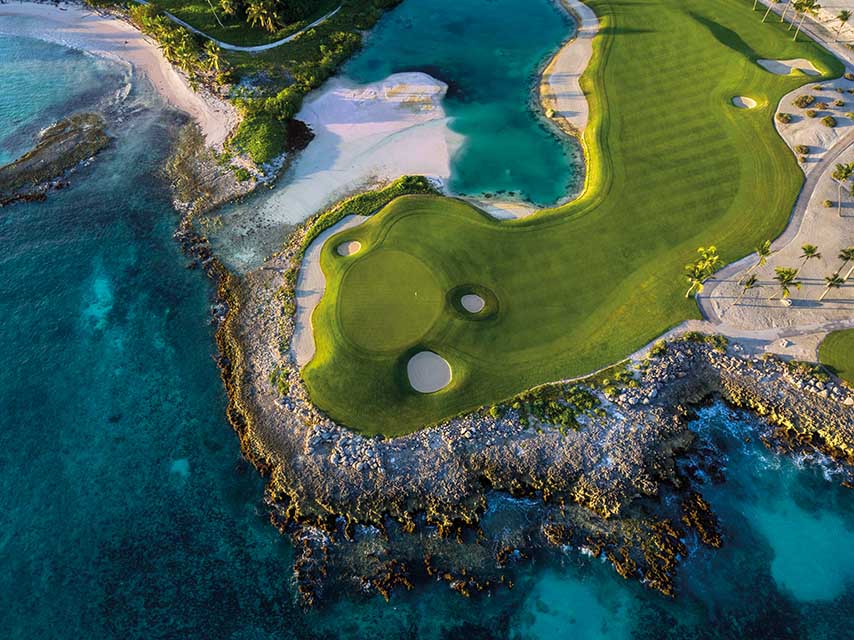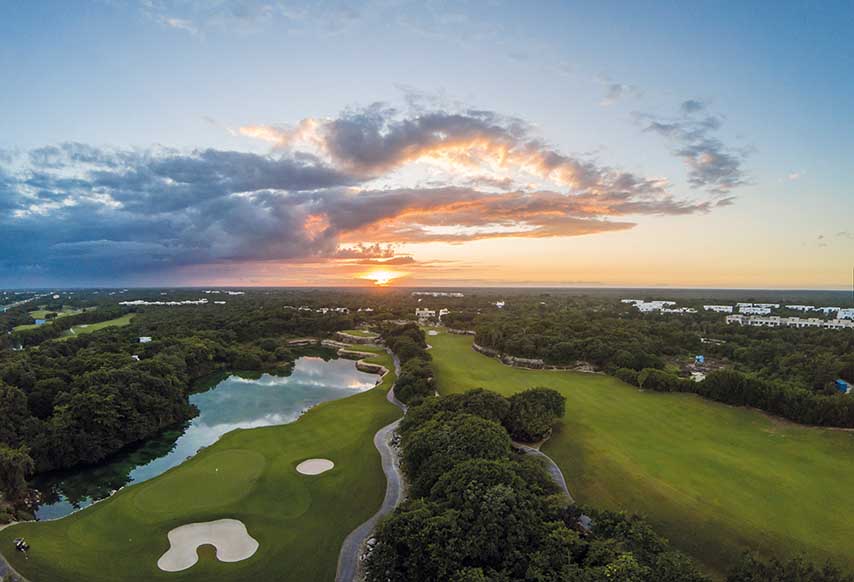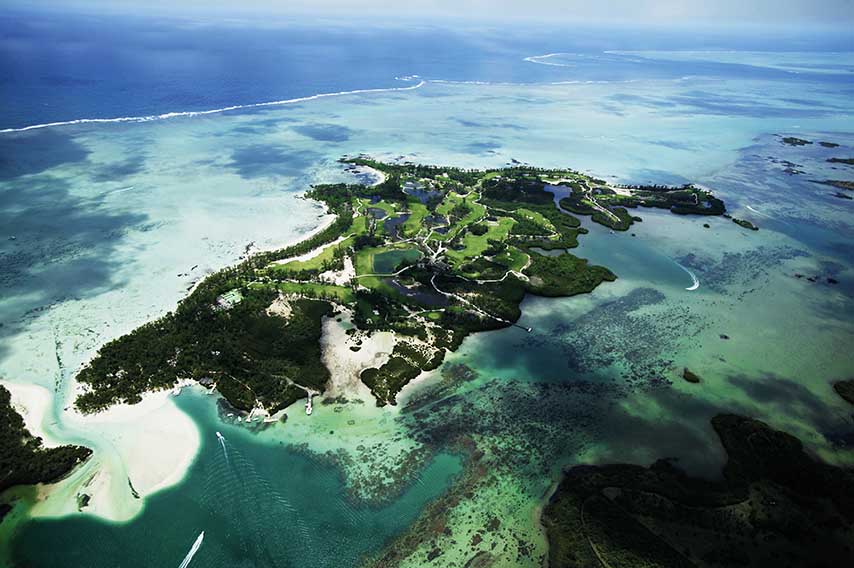There are a just a handful of golf courses of great quality and beauty in the world that also have the added attraction of being nestled in paradisiacal havens. One of them is Punta Espada Golf Club, in the Dominican Republic, specifically in the Cap Cana macro-urbanisation, just 15 minutes from the airport. Opened in 2006, this par-72, 6,762-metre course, lapped by Caribbean turquoise waters, was designed by Jack Nicklaus, who incorporated the area’s natural features into its topography: the cliffs, the beach, the water channels and the exuberant vegetation.
"The Cap Cana terrain represented a challenge in designing Punta Espada,” said Nicklaus during the course’s inauguration, “and inspired us to create the ideal setting for an exceptional golf course for those who are passionate about this sport. It enjoys a privileged natural environment, with all 18 holes overlooking the Caribbean Sea, making it an irresistible course for golfers.”
Efren García-Estrada, director of Punta Estada Golf Club, relates how the legendary star conceived the commission. "When Nicklaus was hired for three Signature designs at Cap Cana, he was given the choice of locating the first of them to make Punta Espada a reality and, like a good artist, he chose the best canvas for his artwork: approximately two kilometres of spectacular coastline that provides the perfect contrast of various shades of blue, the bright green of Paspalum and the clear white tones of the bunkers and landscaped areas."

Selected Holes
With eight holes next to the sea, it is not easy to determine which are the most attractive. According to García-Estrada, it is a difficult choice because for him all are remarkable. Nevertheless, he opts for three. He begins with the second, a par-five he defines as "an incredible hole, both aesthetically and strategically, a well thought out hole that challenges you on each stroke and rewards those who take risks and hit good shots."
Then he mentions the 13th, a par-3 of 225 metres, over the sea and the "Signature Hole"; and also includes in this trio the 17th, a par-four that is simply spectacular "The drive is played over water and those who are more daring will have a much shorter and easier second shot than those who do not take so many risks. It is not a long par-four and it offers a good birdie opportunity if you play it courageously.”
As for the three most difficult holes at Punta Espada, the director lists the 13th, "attractive while also being tough”; the 11th, "a long par-four with a shot to the green that requires a lot of mettle"; and the 18th, "of great difficulty, a demanding, long hole, because usually you hit against the wind and play to a small green, well defended by the sea and two bunkers."
For the final choices, we asked him to specify the most spectacular holes. "The second and third are stunning; the same as the 12th, a par-five that ends on a green with 270 degrees of coastline and outstanding views of Caleton Beach Club, a small but exquisite beach with fine white sand."
World-Class Players
Punta Espada, unquestionably one of Jack Nicklaus’s masterpieces, has an outstanding curriculum as a venue for top-category competitions, especially The Cap Cana Championship, a US PGA Tour Champions event held in 2008, 2009 and 2010. Fred Couples was the winner of the last edition, ending the tournament in fine style with a 10-under 62, which remains the course record. "Thanks to the tournament," recalls Efren García-Estrada, "we were able to see such top players as Greg Norman, Tom Watson, Hale Irwin, Gary Player, Bernhard Langer and Mark O'Meara compete in the Dominican Republic."

Golf Destination
Despite the great fame that Punta Espada and various other courses in the country enjoy, García-Estrada believes the Dominican Republic should be promoted much more as a golf destination.
"We are a premier golf destination," he says emphatically. "We have it all: good weather, good hotel facilities and villas, easy air access and, above all and the most important – impressive golf courses designed by some of the best names in the industry."
"There are four courses that stand out from the rest," he continues, "and they are among the best in the world: Punta Espada by Jack Nicklaus; Teeth of the Dog by Pete Dye; Coral by Tom Fazio; and Playa Grande by Robert Trent Jones Sr and renovated by his son Rees Jones. Of these, the first three are less than an hour's drive away. Apart from these three, there are a handful of other extraordinary courses that offer a wonderful golf experience and would stand out in any other destination. "
"Having said that," he adds, "fate remains a great unknown and the challenge is to continue promoting the destination. The PGA Tour Corales Championship is undoubtedly helping to spread the word about the destination, and we appreciate the effort being made to have this tournament on the island."

Value and Price
Playing at one of the best golf courses in the Caribbean has its price: expensive but not exorbitant, given the value of what is offered. Until 18 November, when the golf season ends there, the green fee is $225 (€197) if the tee time is from 11.40am to 2.30pm, and $295 (€258) if you go out on the course between 7.00am and 11.30am. This latter price at Punta Espada is, together with Teeth of the Dog (at the same price), the most expensive green fee in the Dominican Republic. If you can afford it, do not hesitate – pay it and play the course!
Best in the Caribbean
Golfweek Magazine has ranked Punta Espada as the number one course in the Caribbean and Mexico area for eight consecutive years. This challenging Dominican Republic par-72 course also appears in 76th place in the world rankings produced by Golf Digest.
Mandatory Caddie
It is not that they do not trust their visitors’ golfing skills, but simply that at this Caribbean course caddies are mandatory. Although playing at Punta Espada costs almost $300, the price includes caddy, unlimited practice range balls, golf cart, tees, yardage book, water...
Exceptional Urbanisation
Cap Cana, with its more than 12,000 hectares and 52 kilometres of roads, is one of the Caribbean’s major tourism macro-urbanisations – and, indeed, throughout the world. It offers all kinds of facilities and even has a university campus.
Oldest in the Americas
The capital of the Dominican Republic, Santo Domingo, is the oldest colonial city in the “New World”. Founded by Bartolomé Colón (brother of Cristóbal Colón – or Christopher Columbus) on 5 August 1498, it was the first European settlement in the Americas.




